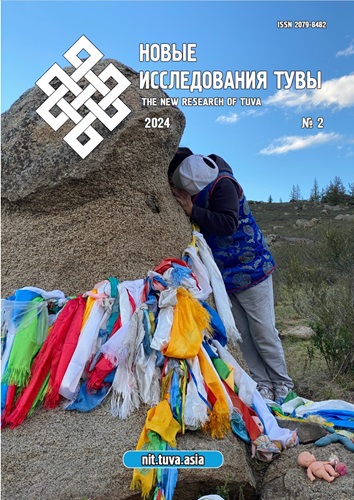Gender differences in adaptive strategies of the population of the Republic of Tuva
DOI:
https://doi.org/10.25178/nit.2024.2.11Keywords:
Republic of Tuva; social adaptation; adaptive resource; adaptive strategy; gender difference; traditional occupation; interregional migration; genderAbstract
The article analyzes gender differences in the adaptive strategies of the population of the Republic of Tuva in terms of choosing ways to improve their financial situation. It also examines the propensity and interest of the population in traditional occupations and migration intentions, based on the results of a recent sociological survey conducted in 2023 among the population of Tuva (sample is 421).
The study found that Tuvan women tend to be more socially active than men. In order to increase their family income, they often choose optimal strategies such as obtaining additional education or changing their profession. They are more willing to take risks, seek to avoid being limited to a fixed income, and search for new market niches to increase their income. In the adaptive strategies of the population in the Republic of Tuva, a general trend has been identified that is related to the desire for well-paid urban jobs and migration outside the republic. Women show less interest in traditional Tuvan occupations as a professional activity and adaptive strategy, and a greater propensity for market-related activities and entrepreneurship than men. Tuvan women are more focused on innovative activities.
An analysis of respondents' migration intentions revealed that women of Tuva prefer interregional migration over intraregional migration. The motives for migration intentions include the desire to find a better-paid job, a promotion, to provide their children with a higher level of education, and to be reunited with relatives.
References
Abylkalikov, S. I., Baimurzina, G. R. and Batalov, R. O. (20230) Migration of the population in Tuva according to the All-Russian Census of 2020. New Research of Tuva, no. 2, pp. 6–16. (In Russ.). DOI: https://doi.org/10.25178/nit.2023.2.1
Anaiban, Z. V. (2005) Women of Tuva and Khakassia during the period of Russian reforms. Moscow, Institut vostokovedeniia RAN. 243 p. (In Russ.).
Anaiban, Z. V. (2019) Social adaptation of men and women during the period of activation of modern migration processes (on the example of Tuva). In: Women and men in the migration processes of the past and present. Materials of the XII International Scientific Conference of the Russian Association of Women's History Researchers of the N. N. Miklukho-Maklay Institute of Ethnology and Anthropology of the Russian Academy of Sciences: in 2 parts / ed. by N. L. Pushkareva, I. O. Dement'ev and M. G. Shenderiuk. Kaliningrad, Baltiiskii federal'nyi universitet im. Immanuila Kanta. Part 1. 535 p. Pp. 225–228. (In Russ.).
Anaiban, Z. V. and Tiukhteneva, S. P. (2008) Ethnocultural adaptation of the population of Southern Siberia (modern period). Moscow, Institut vostokovedeniia RAN. 217 p. (In Russ.).
Anisimova, T. G. (2023) Structural features of the social well-being of the population of Tuva: gender aspect. Humanities of the South of Russia, vol. 12, no. 3 (61), pp. 13–21. (In Russ.).
Akhmetova, G. F. (2022) Migration processes in national republics with different levels of human development: the cases of Bashkortostan, Tatarstan and Tuva. New Research of Tuva, no. 2, pp. 53–69. (In Russ.). DOI: https://doi.org/10.25178/nit.2022.2.4
Balakina, G. F. (2022) Risks in human development in ethnic communities of the Republic of Tuva (1999–2021). New Research of Tuva, no. 2, pp. 20–33. (In Russ.). DOI: https://doi.org/10.25178/nit.2022.2.2
Balakina, G. F. (2023) Adaptation strategies of the population of the Republic of Tuva: The problematic field of research and expert opinions. New Research of Tuva, no. 3, pp. 193–206. (In Russ.). DOI: https://doi.org/10.25178/nit.2023.3.12
Balakina, G. F. and Anaiban, Z. V. (1995) Modern Tuva: socio-cultural and ethnic processes. Novosibirsk, Nauka. 140 p. (In Russ.).
Balakina, G. F. and Anaiban, Z. V. (2016) Features of ethno-regional migration in Tuva. Sotsiologicheskie issledovaniia, no. 10 (390), pp. 85–92. (In Russ.).
Balakina, G. F. and Kylgydai, A. Ch. (2015) Ethnoregional models of adaptation to the labor market in Tuva. Kyzyl, TuvIKOPR SO RAN. 160 p. (In Russ.).
Badmaeva, N. V. and Natsak, O. D. (2021) Modern labor migration from Kalmykia and Tuva: economic, socio-cultural and gender aspects. New Research of Tuva, no. 4, pp. 186–205 (In Russ.). DOI: https://doi.org/10.25178/nit.2021.4.14
Kozyreva, P. M. and Smirnov, A. I. (2016) Features and trends of adaptation of Russians to changing conditions in the post-Soviet period. In: Reforming Russia: Yearbook [collection of scientific articles] / ed. by M. K. Gorshkov. Moscow, Novyi khronograf. Issue 14. 496 p. Pp. 133–171. (In Russ.).
Korel', L. V. (2005) Sociology of adaptations: questions of theory and methodology. Novosibirsk, Nauka. 415 p. (In Russ.).
Kosharnaia, G. B. and Karimova, L. F. (2018) The adaptation strategy of the poor population in the region (gender aspect). Sotsial'no-ekonomicheskie iavleniia i protsessy, vol. 13, no. 103, pp. 27–32. (In Russ.).
Mozgovaia, A. V. (2023) Women’s adaptation to social changes: resource potential. Zhenshchina v rossiiskom obshchestve, no. 2, pp. 47–59. (In Russ.). DOI: https://doi.org/10.21064/WinRS.2023.2.4
Natsak, O. D. (2021a) Gender and demographic features of the labor market of the Republic of Tuva: trends and prospects. Population, vol. 24, no. 2, pp. 120–130. (In Russ.). DOI: https://doi.org/10.19181/population.2021.24.2.11
Natsak, O. D. (2021b) Gender asymmetries of modern Tuvan family revisited. Biulleten' Kalmytskogo nauchnogo tsentra RAN, no. 2, pp. 120–143. (In Russ.). DOI: https://doi.org/10.22162/2587-6503-2021-2-18-120-143
Natsak, O. D. (2022a) Women's Entrepreneurship in the Republic of Tuva: Motives, Barriers and Opportunities. Vestnik instituta sotziologii, vol. 13, no. 4, pp. 68–93. (In Russ.). DOI: https://doi.org/10.19181/vis.2022.13.4.850
Natsak, O. D. (2022b) The distribution of gender-based authority in the modern Tuvan family. Teoriia i praktika obshchestvennogo razvitiia, no. 2 (168), pp. 28–36. (In Russ.). DOI: https://doi.org/10.24158/tipor.2022.2.3
Natsak, O. D. (2023) Single-parent families and single-parent practices of women in modern Tuvan society. Abakan, Khakasskoe knizhnoe izdatel'stvo im. V. M. Torosova. 240 p. (In Russ.).
Nechiporenko, O. V. (2008) Adaptation strategies of rural local communities: new aspects of typology. Vestnik Novosibirskogo gosudarstvennogo universiteta. Seriia: Filosofiia, vol. 6, no. 2, pp. 108–114. (In Russ.).
Nechiporenko, O. V. (2011) The evolution of adaptation strategies of rural society in the process of agrarian reform. Vestnik Novosibirskogo gosudarstvennogo universiteta. Seriia: Filosofiia, vol. 9, issue 1, pp. 85–91. (In Russ.).
Popova, I. P. and Sedova, N. N. (2004) Additional employment in successful adaptation strategies of the population. Sotsiologicheskie issledovaniia, no. 2(238), pp. 31–42. (In Russ.).
Rostovskaia, T. K. and Vasil’eva, E. N. (2023) Challenges of educational migration of Tuvan youth: Demographic aspect. New Research of Tuva, no. 3, pp. 207–219. (In Russ.). DOI: https://doi.org/10.25178/nit.2023.3.13
Chernyshev, K. A., Mitiagina, E. V., Chernysheva, N. V. and Petrov, E. Yu. (2023) Incidence and directions of educational migration of Tuvan youth. New Research of Tuva, no. 2, pp. 70–83. (In Russ.). DOI: https://doi.org/10.25178/nit.2023.2.5
Shmakov, V. S. and Serdiukova, Yu. S. (2013) Features of the use of multidimensional analysis technologies in the study of adaptive reactions of rural society. Vestnik Novosibirskogo gosudarstvennogo universiteta. Seriia: Filosofiia, vol. 11, no. 4, pp. 93–100. (In Russ.).
Buratti, A., Cesaroni, F. M. and Sentuti, A. (2018) Does gender matter in strategies adopted to face the economic crisis? A comparison between men and women entrepreneurs. In: Entrepreneurship. Development tendencies and empirical approach. Ed. by L. Mura. Intech. 472 p. P. 393–412. DOI: https://doi.org/10.5772/intechopen.70292
Dwyer, P. D., Gilkeson, J. H. and List, J. A. (2002) Gender differences in revealed risk taking: evidence from mutual fund investors. Economic letters, no. 76, pp. 151–158.
Powell, M. and Ansic, D. (1997) Gender differences in risk behavior in financial decision-making: an experimental analysis. Journal of Economic Psychology, no. 18, pp. 605–628.
Rad, A., Yazdanfar, D. and Öhman, P. (2014) Female and Male risk aversion: An empirical study of loan officers’ assessment of SME loan applications. International Journal of Gender and Entrepreneurship, no. 6 (2), pp. 121–141. DOI: http://dx.doi.org/10.1108/IJGE-02-2013-0012
Published
How to Cite
For citation:
Natsak O. D. and Balakina G. F. Gender differences in adaptive strategies of the population of the Republic of Tuva. New Research of Tuva, 2024, no. 2, pp. 177-192. (In Russ.). DOI: https://doi.org/10.25178/nit.2024.2.11
Issue
Section

This work is licensed under a Creative Commons Attribution-NonCommercial 4.0 International License.

Author(s) license holder(s) grant rights for their work to the journal (grantee of a license) under the simple non-exclusive open license in accordance with Art. 1286.1 «Open license for a research work, work of literature or fine arts», Civil Code of the Russian Federation.
New Research of Tuva publishes articles under the Creative Commons Attribution-NonCommercial license (CC BY-NC).
Since it is an open license, author(s) reserve the right to upload the article to their institutional repository, submit it to another journal (if it allows republications), or republish it on their own website (in full, or in part).
However, several conditions apply here:
a) The republished version must always contain the name(s) and affiliation(s) of the author(s), the original title and the hyperlink to the original version on the New Research of Tuva website;
b) It must be in open access, free of charge, and no category of readers must be in any way whatsoever advantaged over general readership.
c) should the contribution be submitted elsewhere by its author(s) without substantial modification (30% or more of original text unchanged), the body of the article should contain a disclaimer that the original version was published in New Research of Tuva (with a link to the respective page)
The CC-BY-NC is a non-revocable license which applies worldwide and lasts for the duration of the work’s copyright.










